15 Famous Square Logos + Tips to Inspire Your Design

Squares are popular logo shapes for brands that want to convey trust, stability, and structure. From financial institutions to functional clothing, square logos have long been used to communicate business values and products at a subconscious level. The associations of square logos go beyond language barriers and can even be used to establish a brand internationally!
Squares are strongly associated with stability and structure. Where circular shapes are found in nature, squares are more often found in human-made structures.
If you’re thinking of using a square logo for your logo design, we’ll cover iconic square logo examples and how to nail this look.
Famous square logos and why they work
We’ve analyzed some of the most popular square logos so you can understand their design, and find some inspiration for your own!
1. BBC
The U.K.’s broadcasting center has one of the most recognizable square logo examples. When the network’s logo first launched, it was comprised of multiple circular iterations to differentiate between channels (BBC Education, BBC News, etc.). In the 1980s, the decision was made to modernize the branding. The box lettering was contained in squares and became the new logo.
Why it works:
The simple, strong square shapes have truly stood the test of time. The BBC square logo is a fantastic example of how simplifying your branding can leave you with the most impactful, core elements. It’s also easier to recognize and print on merchandise both on and offline.
2. American Express
American Express has the perfect example of a square logo. As a financial organization, the company needs to communicate security and trustworthiness. Their simple blue design with a sans serif font has changed very little since its inception. These elements are designed to express the company’s brand personality perfectly— including the flashy gradient, which enhances the opulence that Amex has always conveyed.
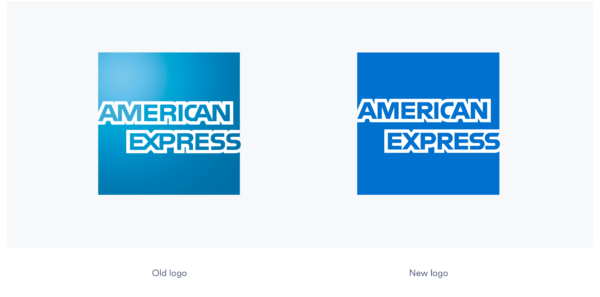
Why it works:
The American Express logo uses three solid elements. The square contains and secures the logo. The color blue is widely associated with stability and reliability. Finally, the bold, slab font is assertive and gives the impression of strength and fortitude. In unison, the logo conveys the perfect message for a banking corporation.
3. Gap
Gap’s square logo design is so iconic that when the company tried to rebrand in 2010, there was a massive public outcry. The new version was scrapped after just one week! Even after Gap changed its logo again in 2016, most people still associate the brand with its classic blue square.
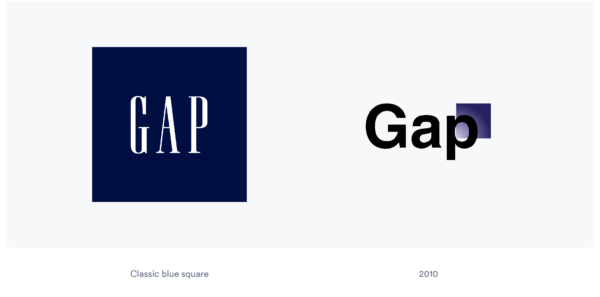
Why it works:
Similar to American Express, Gap has all the elements of a robust and impactful logo. Gap’s decision to use a serif font establishes the ethos of tradition, age, and establishment. As a long-standing retailer, this matches their brand identity perfectly. It’s also interesting to note that the newest Gap logo — an inversion of the original square — still heavily relies on the Spire logo font, something fans of the brand were disappointed to see go in the rebranding attempt.
4. Lego
Who hasn’t played with Lego? Another long-established household name (it was founded in 1932!), the company added a yellow square to its logo in the 1950s. It wasn’t until the 60s that the logo we now know and love started to take shape (…get it?). The red, yellow, and white brand is universally recognizable and serves as a more playful square logo inspiration. It’s easily the most famous red square logo!
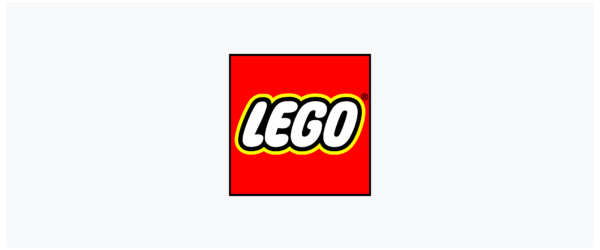
Why it works:
The Lego red square logo works well because it retains the feel of security and reliability with its geometry, while still appearing playful enough to appeal to children. The bright colors and rounded font are especially captivating for young eyes, while the associations that come with a square logo immediately reassure parents.
5. Microsoft
The current Microsoft logo is a relatively new creation. Before 2012, the company used a simple, black-and-white wordmark logo. It used boxy fonts since the 1980s, with relatively little change. Today, the new logo symbol design can be recognized worldwide without the company name. This level of recognition is the mark of a truly successful square logo.
Why it works:
Although the logo is simple, it packs a punch symbolically. The four colored squares denote the branches of Microsoft’s business; blue for Windows, red for Office, green for Xbox, and yellow for Bing. Each color was specifically chosen to represent the personality of the department. This clever design tactic, alongside the symbolic use of squares, is the perfect example of a clean, minimal logo that has considerable depth.
Ready to make your own square logo?
6. Domino’s
Domino’s logo hasn’t changed much since its creation in the 1960s. The three domino dots were created to represent the three locations that existed. The pizza company’s initial plan was to add more dots as new venues opened, but, as you can imagine, that would make for a lot of dots! Except for a small flip, the logo didn’t change again until 2012. Today, it’s a simple wordmark logo with the square dominos symbol nearby— sometimes above it, sometimes beside it.

Why it works:
Domino’s is a fantastic representation of how consistent branding can make or break a company. Whether it’s on cars, pizza boxes, or flyers, the red and blue square symbol is instantly recognizable. The orientation or scale of the logo doesn’t matter; it will always be related to the beloved pizza franchise. Domino’s is now such a well-known brand that it doesn’t need to include the word ‘pizza’ anymore. This fact shows the success of their branding strategies throughout the years.
7. Uniqlo
When the Uniqlo logo was first developed, it was based on a mistake. The brand was meant to be called “Uni-Clo” – an abbreviation of “Unique Clothing.” However, a typo on the company registration form meant a permanent business name change. The logo itself heavily relies on the name and is inspired by the store’s home country, Japan. Initially, it was a red logo with solely English letters, but an update in 2006 changed the hue and added a Japanese-alphabet version. It was with this branding that Uniqlo found international success.

Why it works:
Reliability is a key factor for an international company. The strength associated with squares helps communicate this sense of establishment and trust. The logo also expresses its origins using color combinations— the red and white scheme is identical to that of the Japanese flag. Red is also seen as a dominant color, which is known to inspire a powerful, passionate psychological response.
Plus, the choice to add a Japanese-language version only solidified the eastern feel of the design. Finally, the overall design is incredibly similar to the modern-day seal, used in Japan to mark official documents. This style choice only furthers the Japanese design aesthetic of the brand.
8. MTV
The MTV logo is a fantastic example of using squares to influence design without actually including the shape. MTV’s boxy font has been a staple in the logo since its conception in 1980. The thriving graffiti culture of the time inspired the designers, who used the look to establish the channel as a hip and on-trend network. The other unique factor is the lack of a set color scheme. Whether in black-or-white or seasonal hues, the square logo is recognizable all year round.
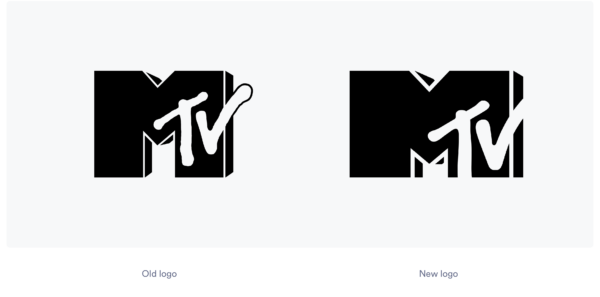
Why it works:
MTV is still able to communicate the strength and stability associated with squares, without the element of constriction that comes with surrounding it in a box. With this design choice, it captured the freedom of their young audience while retaining their strength and authority as a brand. Their use of shape is so powerful that the brand doesn’t even need color to make a splash.
9. 7 Eleven
7 Eleven is a perfect proprietor for a square logo. Known all over the world as a reliable convenience store, 7-Eleven’s use of the square suggests dependability and grounding. However, the logo has other significant factors. The lowercase ‘n’ was an intentional choice, as the designers decided it would be friendlier to end on the curved lowercase option than go with all-caps.
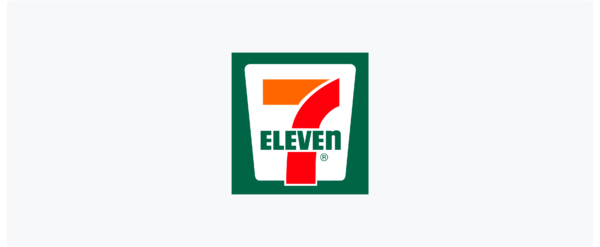
Why it works:
7-Eleven’s logo plays with our emotional responses. The logo draws attention with the square, but then purposefully includes softer elements like the rounded edges and lowercase n. The unusual choice to use a lowercase ‘n’ changes the overall tone of the logo. It also provides an interesting talking point that increases word-of-mouth marketing for the company.
10. T Mobile
Designing a square logo doesn’t have to mean taking a wordmark or monogram and putting it inside a box. In fact, more out-of-the-box thinking can be more impactful! T Mobile is a fantastic example of more obscure square logo designs. The main logo element is the traditional serif font wordmark. What would have been an archaic-looking design is modernized by the addition of five small squares. These squares serve a purpose, connecting the start and end of the words, emphasizing the element of “connectivity” essential to a telecommunications brand.
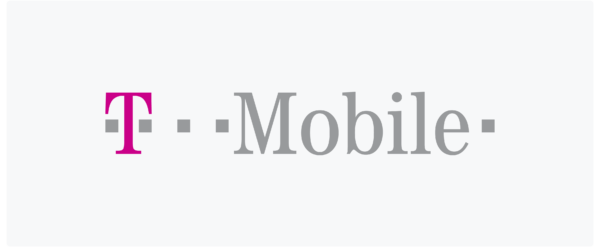
Why it works:
The square logo design still communicates trust, but without the constriction of a square container. As the wordmark isn’t contained, it communicates the freedom closely associated with mobile networks. The logo is so impactful that it’s recognizable from the “T” (and two squares) alone. The magenta color has become a defining factor of the brand; the company has trademarks on the hue to stop others from diluting their brand personality.
11. Notion
Notion is a project management software that helps people and businesses stay organized. What shape better conveys structure and organization than a square? Notion adopted a cube with a monogram “N” to be memorable and distinguish themselves from the already crowded project management space.

Why it works
Notion uses a cube logo symbol to symbolize its role in structuring your notes, projects, and business. Just like a building block! Although a cube would normally appear cold and structured, Notion rounded the edges to create a softer, more approachable look. The black and white color palette keeps the logo distraction-free and clean – just like their product!
12. Linkedin
Professionals rely on Linkedin for industry news, job opportunities, and professional networking events. Their brand needs to convey professionalism, trust, and community, so it used a modern font and a strategically placed square around the “in”. The logo hasn’t changed much over the years, except adopting navy blue to inspire emotions of loyalty and trust.

Why it works
Linkedin’s square logo emphasizes “in”-clusion and professionalism. The logo has a boxed “in” as a symbol and as part of their wordmark. The edges around the square have been rounded to appear less rigid and more inviting as a social network. Linkedin used a simple blue square to convey its stability and professionalism and used the navy to further associate them with a trustworthy and community-oriented platform.
13. Square
Square is a payment processing platform that allows small businesses to securely accept customers’ payments right from their mobile phones. Security, trust, and professionalism are critical, so the brand has squares within a square to seal the deal! Not to mention, using “square” as a brand name to reference being even or “getting square”.
 Why it works
Why it works
There’s no better example of a square logo than Square. The logo is shaped after its first product, a square portable card reader that can make secure payments from a mobile. The logo and the product are simple and functional, with soft rounded corners and a minimalistic design aesthetic. The brand uses a modern font with pristine lettering and crisp legibility to add to its sturdy, functional, and trustworthy look.
14. Financial Times
The Financial Times is an authority in financial news, with many readers subscribed to get the latest and greatest of the financial world. With such serious subject matter, the square logo is ideal for printing or placement on letterheads, newspaper layouts, and advertisements. The logo is a simple “FT” monogram within an orange square, but the letters are skewed to the top of the box.

Why it works
The Financial Times differentiated itself from red and blue competitors through color and layout. It used an orange square with its monogram deliberately placed at an unusual top skew. Unlike many of the examples above, the square logo symbol has razor-sharp corners paired with a traditional serif font to create a sense of authority, tradition, and class. It’s befitting for a cut-throat industry like finance and newspaper publishing!
15. Trello
Trello is a project management tool that uses a blue square to convey structure and trust to its users. Since it exists as an app, the square logo works well as an app icon and clearly relays that it’s a productivity tool. The vertical lines portray progress and a depiction of its kanban-style chart layouts. Brands that mainly exist as apps usually go for the square logo icon to stay uniform with their medium!

Why it works
Although blue is one of the most commonly used app logo colors, Trello differentiated itself by adding a slight gradient and using unique white vertical lines. In shape psychology, vertical lines symbolize progress while the square adds a sense of structure and authority. Trello uses a unique sans serif font that has a balance of soft whimsical curves and sharp rigid edges. It’s truly unique and memorable!
Tips for designing your square logo
The above examples provide inspiration for your own square logo design. But, if you’re still struggling to apply them to your own design, here are some suggestions to consider:
1. Consider your layout
Would your logo work best with a box or an outline? Or could you use smaller square shapes within the design? Perhaps you don’t even need to use an actual square, rather, incorporate the elements of a square logo using boxy fonts or symbols.
- Made with Looka logo maker
- Made with Looka logo maker
2. Wordmark, monogram, or none?
Consider the length of your company name and whether you want it as part of your logo. If it’s long, maybe a monogram within a square works better than the full company name. Shorter, more concise logos tend to make a more memorable impression.
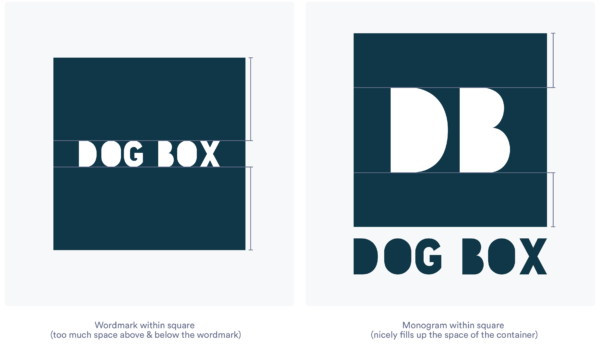
3. Full-color or outline only?
Play with filling the square with a color, or leaving it as an outline to see which you find more impactful. Which option best communicates the message you’re trying to portray? Sometimes an outline can draw attention to what’s inside the square logo in a more refined way, whereas a color-filled square is bolder and attention-grabbing.
- Made with Looka logo maker
- Made with Looka logo maker
4. Consider a symbol
Symbols are incredibly powerful tools when it comes to brand recognition. A logo symbol is more likely to be recognized than a brand name. Consider Nike, Twitter, Shell, or even Microsoft.

5. Try secondary elements
Squares are sharp and ‘edgy’ and if you’re trying to find a balance, consider using other softer elements of the logo. Consider how 7-Eleven and T-Mobile chose secondary elements to make a more complex brand personality.
6. Check your competition
Your logo exists in the bigger scope of your industry. Make sure to compare it to your competitors and gauge if it stands out or blends in.
Not sure if a square logo is for you?
There are a ton of logo shapes to choose from if the square doesn’t resonate with your brand. Here are some other shapes and types of logos to consider:
Create a successful square logo with ease
If you want an impactful logo, a square might be the best shape for you to work with! Remember to consider how you’ll incorporate your business name, research your competition, and create a strong color palette.
These tips will help you narrow down your options and develop a clear idea to create a logo that is:
- Strong
- Trustworthy
- Well-established
If you want to play around with how your logo might look using squares, check out our free logo maker. The design process is quick-and-easy, so you can experiment with your ideas and get a professional quality end product.





